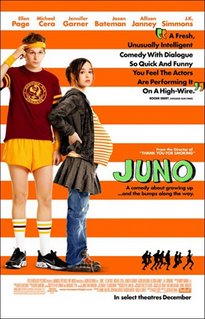Movie Minutes

Atonement: There was one moment in this otherwise too-dramatic-for-me film that I found moving, when the wrongly imprisoned young man, about to head to France to serve the rest of his jail term fighting in World War Two, meets with his young love and reaches a trembling hand out to touch her hand. That was it. At the end of the movie, when Vanessa Redgrave shows up to play the aged writer, the woman whose story had sent a man to jail and to war, I caught a glimpse of how interesting the novel must be. But I didn’t think the film was, very.
Winter Passing: The premise of this sounded so intriguing. An editor contacts the grown daughter of two esteemed writers, offering her $100,000 for publication rights to their love letters. The daughter, who is down and out, grieving the recent death of her mother and estranged from her father, thinks this might be an easy way to make some money, and goes home to collect the letters. Her father is a drunk and mired in writer’s block; one of his students, a woman somewhat younger than his daughter, lives with him as his cook and housekeeper (she’s thankfully not too fawning, nor does she seem to be sleeping with him — which would have been a tired old eww!), while Will Ferrell works as his handyman and security guard. If you love Will Ferrell, then maybe you could get past Ed Harris as the annoying cliche of the wild alcoholic writer, because Ferrell’s performance is compelling and nuanced. But I don’t love Will Ferrell enough. This is one of those movies that referred to, but did not tell, the story that interested me: the mom! What did she write, and what was her relationship with her daughter like, and what was her marriage like, and what did she write? What did she write?!? Oh, well.
My Kid Could Paint That: Oh, this one kept Tony and me up talking way past our bedtime! This is a documentary about Marla Olmstead, a child who paints. Because her father is a painter, and he wanted to get some work done one day, he gave her a canvas, some paints and brushes, and got to work while his daughter covered her canvas with a bright, abstract, typical preschool painting. Except, you know, on a proper canvas with quality paints, so it looked really, really good. A friend saw it and asked to hang it in his cafe, where a gallery owner saw it and asked if there were more, and before long, four year-old Marla Olmstead had a show. And then buyers. And then another show. And then some press. And then some very big sales. And then of course came the skeptics, led by 60 Minutes, to suggest that her daddy was really directing, if not in fact just doing, the paintings himself.
But the “Is she or isn’t she?” question wasn’t really the question that interested me so much. First, there’s the problem of abstract art (which we happen to be fans of in this house), and people’s strong reactions against it: It’s too easy; anyone can throw paint on a canvas and say “It’s a painting!” It doesn’t tell a story. It’s impossible to evaluate its quality (because of its refusal to represent “reality”). It thumbs its nose at the viewer as if to say, If you don’t like me, it’s because you’re not smart enough to get me. In the documentary, the strongest voice against abstract art happens to be the gallery owner representing Marla, a photo-realist painter who devotes months to a single painting and is peeved at how quickly she produces work. But not peeved enough to avoid making a buck on it.
But what made Tony and me both really sad was one tiny moment toward the end of the film, when Marla is painting and asks her dad to paint with her. And because of the skeptics, and because of all the money involved, he has to say no. The minute he kneels down to paint a picture with his little girl, the whole structure of her career collapses. But it seemed to me that their family had collapsed in some important way already, without their even noticing.
Persepolis: I thought the books were very good, though they didn’t knock me out (they’d been built up too much, I’m afraid). But at the risk of building up anticipation for the film too much, I thought it was spectacular. Here’s a rare instance when translating a book to film opens it up and deepens it; rather than the flat black & white images on the page (which are quite moving in their simplicity), the film gives you black & white and a thousand shades in between, moving subtly on screen, with incredible depth and beauty. Yes, the story’s been simplified a bit, but the film tells such a compelling story, I had to sit in the theater a while after it had emptied out and collect myself before I could leave.











